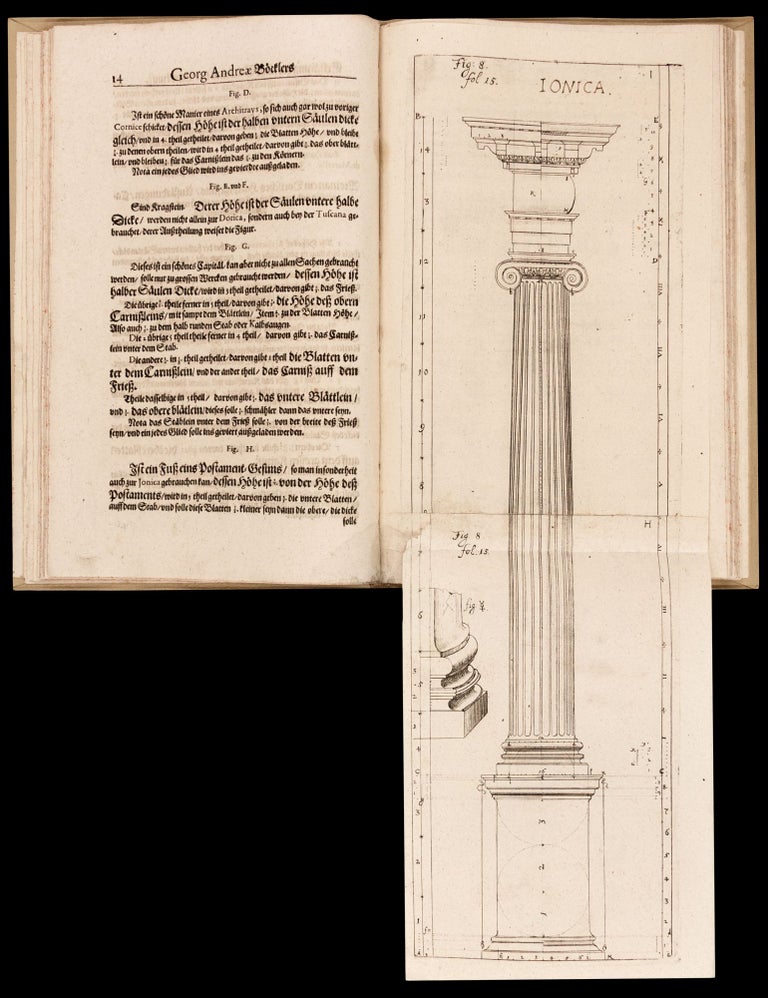
Neues und zuvor nie also eingerichtetes vollkommenes Seulen-Buch.
Folio [32.0 x 20.5 cm], (6) ff., 60 pp., with (40) engraved plates (12 of which are here assembled to form 6 two-plate folding leaves), title page in red and black, woodcut headpieces and initials. Folio [32.0 x 20.5 cm], (6) ff., 60 pp., with (40) engraved plates (12 of which are here assembled to form 6 two-plate folding leaves), title page in red and black, woodcut headpieces and initials. Bound antique-style cartonato, red sprinkled edges. The occasional contemporary annotation, occasional pale marginal dampstaining, mends to figures 20 and 24, mends to two holes in title page (cancelled inscriptions?) not affecting text. Rare first edition, third issue, of an extensively illustrated German-language comparative treatment of the classical Orders by the Nuremberg architect-engineer Georg Andreas Böckler (c. 1617-87). In this practical treatise Böckler cites his indebtedness to the writings of Vitruvius, Archimedes, Palladio, Scamozzi, Vignola, Barbaro, Serlio and Hans Blum (Serlio’s principal interpreter in Germany, c. 1520-60), and his 40 full-page etchings carefully describe the Doric, Ionic, Corinthian, Tuscan and Composite systems. Unnamed influences include Joseph Furttenbach (with whom Böckler was in contact), Abraham Bosse, Le Muet and Freart de Chambray (see Kruft, p. 175). The Seulen-Buch was intended not only for amateur enthusiasts of architecture, but also for practical use by “builders, stonemasons, and carpenters,” an audience who would have been well served by the vernacular text of the treatise and by Böckler’s inclusion of a glossary defining Greco-Roman architectural terms in simple German.
Böckler, who from 1678 served as an engineering consultant in the court of Margrave Johann Friedrich von Brandenburg-Ansbach (1654-86), seems always to have been principally interested in the hands-on aspects of building, and in his extensive writings, when he approaches the architectural theory of ancient and renaissance authorities, he generally does so as tastemaker digesting a sophisticated literature for practical craftsmen operating on the ground (see Rossbach, passim). The Seulen-Buch’s ample, clearly presented engravings and its step-by-step instructions (written in the imperative) for properly measuring each of the myriad components of this type of ornament would have made the book an invaluable resource on the building site or in the mason’s shop.
Böckler’s work on the Orders first appeared in 1663 under the title Architectura civilis nova & antiqua (Frankfurt, J. G. Spörlin) and then again under the same title in 1680 (Frankfurt, B. C. Wust). The present Seulen-Buch and these two issues of the Architectura civilis nova & antiqua were, in fact, printed at precisely the same time and are identical apart from newly printed title pages. With the Seulen-Buch the Latin title was dropped in favor of a German title, apparently to emphasize the approachability of what was, after all, a practical manual written in the vernacular. Böckler’s earlier treatise on the Orders, the Compendium Architecturae Civilis, Erster Theyl (Frankfurt, Götzen, 1648), is different from these books both in its text and illustrations and represents the author’s first thoughts on the subject. (Krufft remarks that it appeared in the same year as the Treaty of Westphalia and was, “intended to contribute to the rebuilding of Germany after the devastation of the Thirty Years’ War” [p. 175], an assertion which, given then popularity of Böckler’s writings, perhaps warrants further investigation in regard to surviving buildings from the time/region).
Böckler is best known today for his work on theoretical and applied hydrodynamics, with his Theatrum machinarum novum (1662) and Architectura curiosa nova [1664] treating fountains, water-jets, garden fountains, well heads, grottoes, windmills, pumps, and other hydraulic machines. His German-language adaptation of the first two books of Palladio appeared in 1698 as Die Baumeisterin Pallas.
OCLC locates only one U.S. copy of this 1684 Seulen-Buch (Columbia). The 1663 Architectura civilis nova & antiqua is held by Princeton and the Getty, while no U.S. copies of the 1680 issue are recorded.
* Berlin Kat I.1961; Fach-Katalog der Aargauischen Kantonsbibliothek, vol. 2, part 1, p. 755; H.-W. Kruft, Architectural Theory, pp. 175-6; N. Rossbach, “‘Zu bessere Begreiffung aller Materien’: Wissenorganisation und -vermittlung bei Georg Andreas Böckler, Architect & Ingenieur,” Polyhistoriusmus und Buntschriftstellerei, F. Schock, ed., pp. 149-67.
Sold
